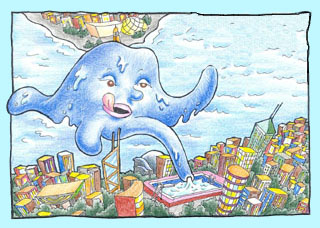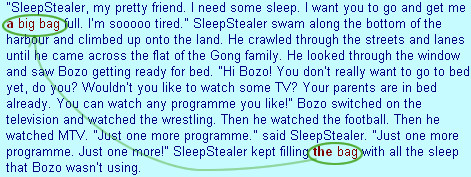Grammar: Word classes: Determiners: Referring to specific people, things, etc
| Definite article (the) |
Using the to point backwards
When we use the definite article the to point backwards, we can do so by pointing to different items of language:
|
an earlier occurrence of the same noun |
|
|
a different noun |
|
|
an earlier stretch of text |
Pointing back to an earlier occurrence of the same
noun
Perhaps the most common way of pointing backwards is to an earlier occurrence of the same noun:
|
|
Here the in the boat signals that we are
expected to know which boat the writer is pointing to. We can
identify which boat is meant by going back to a boat in the previous sentence. In
this example the two nouns involved are the same, ie they are both boat. When it
is first mentioned, boat is preceded by the indefinite article a (general
reference), and
when it is mentioned the second time, it is preceded by the definite article the
(specific reference).
However, when pointing backward to the same noun ![]() (especially within one sentence), it is more natural to use a
pronoun
(especially within one sentence), it is more natural to use a
pronoun ![]() instead of the + noun:
instead of the + noun:
MegaMonster stretched out a tentacle until
the tentaclereached into a swimming pool.MegaMonster stretched out a tentacle until it reached into a swimming pool.

|
Nevertheless, in some contexts we prefer the + noun:
|
|
when it is unclear which of several nouns the pronoun points to: |
The Gong family had a dog and a cat.

Itwas called Barney, anditwas called Felix.
The dog was called Barney, and the cat was called Felix.
|
|
when some new information is added to the noun: |
MegaMonster emptied a swimming pool in Hung Hom. The open air swimming pool was very popular with children.
|
|
when the second mention of the noun is some way distant from the first mention: |
 |
Grammar books for second language learners often suggest that we always use the + noun when we are pointing back to a noun that has been used previously. However, when teaching the use of backward pointing the, you need to set up a context for its use and carefully explain the circumstances when it is appropriate to use a pronoun and when it is better to use the + noun.
Pointing back to a different noun
Sometimes the definite article the is used with a noun that is different from the noun to which it points back but which refers to the same Thing:
 |
Here there is a relationship between a mysterious glow and the beam of light. Our ability to work out the identity of the beam of light depends on knowing that there is a meaning relationship between a beam of light and a mysterious glow. This meaning relationship is created by the physical fact that light glows, thus relating light and glow in language.
Another example shows a
relationship between a 'proper name' (or 'proper noun' ![]() )
and a common word (or 'common noun'
)
and a common word (or 'common noun' ![]() ) for the character first introduced by name:
) for the character first introduced by name:
 |
Here there is a relationship between GrumpyGhost (the name of the ghost) and the ghost (the common noun for such a creature). Our ability to work out the identity of the ghost relies on knowing that here there is a meaning relationship between proper names or proper nouns and common words or common nouns. (Because GrumpyGhost is a name, it will generally not have any article preceding it.)
Pointing back to an earlier stretch of text
Sometimes backward pointing is not to an earlier noun at all but to a whole stretch of text:
|
|
|
|
In this example, the answer points back to what GrumpyGhost said in the
previous sentence. Other nouns commonly used with the to point back to earlier
stretches of text in this way are result, issue, question, problem and situation. Tell me more ...
The uses of the
Using the to point backwards
Using the to point forwards
Using the to point outwards
Using the for making general statements
Omitting the
|
||
To give us feedback about this section, click here or on the Comment button at the top of the screen.
If you have any questions about this section, visit the Language Corner.
If you have any questions or suggestions about how to teach this section, send a message to the Teaching Corner.